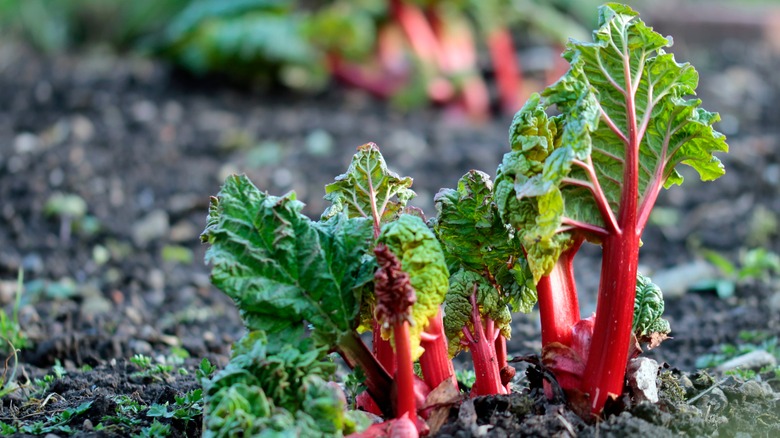The Top Tip You Need For Harvesting Rhubarb
The little red points sticking out of the dark earth is one of the earliest signs that spring has sprung. Along with robins dashing through yards looking for worms, rhubarb is a tell-tale sign that winter is over and the growing season has begun.
According to Food Network, rhubarb is a member of the buckwheat family and is a vegetable that is ready for harvest starting in late March to early April. However, Taste of Home states that it's best to wait until May, June, and July for picking. Any later and the plant doesn't have as much time to grow and get ready for the winter months. To know when to harvest your stalks of rhubarb, don't rely on color alone. Taste of Home advises that it's best to harvest them when they are 7 to 15 inches long. You also want to let the plant mature a bit before you start to harvest its stalks, according to Taste of Home, which advises waiting until the plant is one year old. So, before you head out into the garden with your knife to cut down the rhubarb stalks, there is something you need to know because you may have been harvesting your plant wrong all these years.
Twist, don't cut
You don't need a knife when your rhubarb stalks are ready to be picked and made into something delicious. Instead, grab the stalk near its bottom. Then, according to MasterClass, with a gentle motion, tug and twist the stalk. As you grasp the rhubarb stalk, Taste of Home states to take the stalk to the side while twisting and pulling it upward. By doing this, the stalk should separate neatly from the plant near the roots. If, however, you find it hard to get the stalk to separate from the plant, MasterClass recommends using a sharp knife and going as low as possible with the cut. It's best to avoid using a knife to harvest your rhubarb because when cut, the plant becomes more vulnerable to bacteria and fungus.
Also, as tempting as it is to harvest a lot of rhubarb for jelly or pie, Taste of Home advises only taking up to ⅔ of the plant to make sure there is enough of the plant left to grow the following year. But if you harvest more than you can use while it's fresh, it's OK to freeze it. When you do harvest the stalks, you are also taking some of the plant's leaves, which can't be eaten because they are considered toxic to both humans and animals. MasterClass states that you can, however, compost them. Even without the leaves, you will be left with plenty of rhubarb to create your favorite rhubarb dessert.

